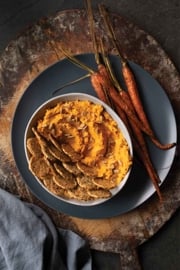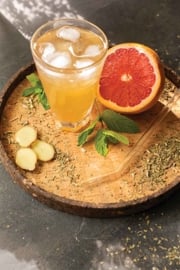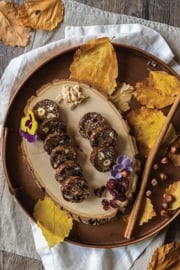
Garden herbs are bountiful in summer. Parsley, sage, rosemary, and thyme work in harmony with garlic and paprika in this yogurt-based marinade. Slathered over a spatchcocked chicken, which shortens cooking time, the marinade helps to tenderize s and add fragrance to the meat prior to grilling or roasting. The finishing touch is fresh plum salsa, with a hit of gentle spicy heat, served slightly warmed and drizzled over the chicken before serving.
Chicken confusion
Chicken is an intensively reared agricultural product, and terminology used doesn’t always make things clear. Here’s some insight into terms you may encounter when purchasing a chicken to help you make the choices that are right for you.
Free run versus free range
Free run means chickens are not kept in cages and are free to roam, but conditions may be crowded indoors. Free range indicates they have to outdoor pasture but may be kept in similar crowded conditions indoors. Standards can vary from farm to farm as there is no set definition for these terms. At smaller local farms, you may be able to visit and better understand the practices.
Raised without antibiotics
Chickens raised without antibiotics placed in feed.
Organic
Chickens raised to standards of a relevant organic certification board, usually raised on organic feed free of animal biproducts or antibiotics; any supplements must be approved by a certification body.
Heritage breed
Refers to poultry breeds that were popular before modern farming, or prior to mid-20th century. Often, they’re slower growing and reared less intensively. They also may be reared by smaller, local farms.
Beware of marketing terms like “grain-fed,” “hormone-free,” and “steroid-free.” All chickens are fed grain and, in Canada, hormones and steroids are banned, so it’s a bit like saying “gluten-free lettuce.”
Garlic goodness
Studies have shown that garlic has anti-inflammatory effects and has long been recognized for its healthful properties. Garlic supplements have been associated with improved cardiovascular health and reduced risk of colon and gastric cancers.
This recipe was originally published in the July 2025 issue of alive magazine.
Grilled Spatchcocked Chicken with Summer Herbs and Serrano Plum Drizzle
Ingredients
- 1/2 cup (125 mL) plain Greek yogurt
- 2 Tbsp (30 mL) extra-virgin olive oil
- 3 garlic cloves, peeled and crushed
- 2 Tbsp (30 mL) fresh finely chopped sage
- 1 Tbsp (15 mL) fresh finely chopped rosemary
- 2 Tbsp (30 mL) fresh thyme leaves
- 1/4 cup (60 mL) fresh finely chopped parsley
- 1/2 tsp (2 mL) sweet smoked paprika
- 1/2 tsp (2 mL) black pepper
- 1/2 tsp (2 mL) salt, divided
- 9.5 lb (4.3 kg) whole chicken, spatchcocked
- 3 black plums, pits removed and diced
- 1/4 serrano pepper
- 1 Tbsp (15 mL) tomato paste
- 1 Tbsp (15 mL) sherry vinegar
- 1 Tbsp (15 mL) honey
- Pinch salt
Directions
01
In casserole dish large enough to accommodate chicken, combine yogurt, olive oil, garlic, sage, rosemary, thyme, parsley, paprika, pepper, and salt. Add chicken and rub with marinade on all sides. Place breast side up, cover, and refrigerate for 4 hours.
02
How many lemons
You’ll need 5 to 7 lemons to yield 1 cup (250 mL) of juice. Add a few more to have some for garnish.
When ready to cook, preheat oven to 425 F (220 C). Remove chicken from refrigerator, place on parchment-lined baking sheet to come to room temperature while oven heats. Roast in preheated oven for 40 to 45 minutes, or until chicken reaches an internal temperature of 165 F (74 C). Alternatively, heat outdoor grill to 400 F (200 C). Grill chicken breast side down over direct heat, with lid closed, for 5 to 10 minutes. Flip chicken, turn burner off, and keep lid closed. Roast for 40 to 45 minutes. Once cooked, remove chicken to cutting board and allow to rest, covered, for 20 minutes.
03
While chicken rests, make plum drizzle. In bowl of food processor, add plums, serrano pepper, tomato paste, and vinegar. Blitz until smooth. Add honey and salt. Just prior to serving, heat gently on low heat, until just warm.
04
Cut chicken into pieces to provide variety and make it easier for guests to serve themselves. Remove wings. Remove and separate breasts and slice into several pieces. Remove leg from thighs. Arrange the pieces on family-style platter and drizzle with sauce.





